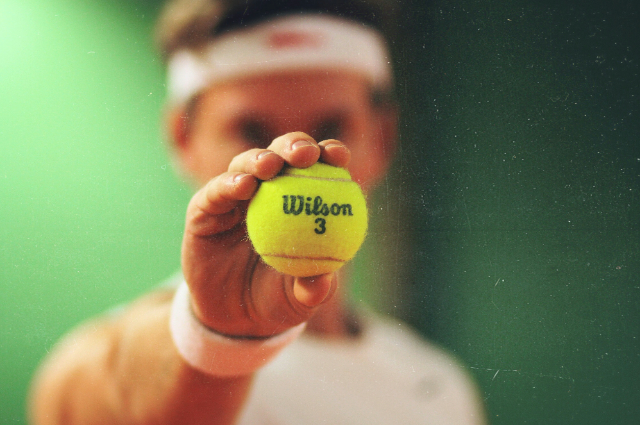
Photo by John Fornander on Unsplash
Tennis ball colours have evolved, but the International Tennis Federation (ITF) only allows yellow and white balls to be used in official tournaments. Traditionally, tennis balls were exclusively white. Since research revealed that tennis balls with optical yellow fluorescent colours were more visible on television, most tennis balls produced have been coloured this way since 1972. The ITF knows this unique ball colour as "optic yellow." #ccff00 is the hexadecimal code of the colour "Fluorescent yellow or Electric lime."
How About Keeping the Ball White?
In the middle of the white tennis balls' standard power, visibility was difficult, especially under different lighting conditions. Consider this: on a bright, sunny day, chasing a white ball across the sky became a game of visual gymnastics, leading players to lose sight mid-flight. Determined authorities journeyed to find a tennis ball colour that would boldly pop on the court, revolutionizing the game!
Visibility Issues
Embracing the brilliant colours of yellow and green tennis balls improves visibility on the court, but challenges remain. Consider the intensity of a match played under artificial lighting, where the ball's colour takes centre stage. The changeable lighting circumstances add an exciting element, making it critical to choose a shade that commands attention, assuring smooth visibility in every thrilling moment! When selecting the official ball colour, tournament organizers focus on visibility in different lighting conditions to provide players and viewers with an easy and entertaining experience.
The Chemistry of Yellow and Green
In professional matches, visibility in different lighting conditions is crucial in choosing a tennis ball colour. In the vivid world of tennis balls, yellow and green colours were chosen carefully to maximize visibility. Yellow, for example, is more visible than white. Because the human eye is more sensitive to yellow wavelengths, a yellow ball stands out against various backdrops.
Green, on the other hand, provides excellent visibility, particularly on clay courts. The balls' and surfaces' contrasting colours make it easier for players to track the ball's movement. This colour breakthrough has tremendously impacted the dynamics of tennis games, improving the whole playing experience.
Influence on Player Performance
The colour of a tennis ball isn't only for show; it can also affect player performance. According to research, players may react faster to specific colours based on their visual choices. Some players believe that yellow balls are easier to see than green balls.
Colour's psychological impact cannot be ignored. The colour of the ball a player is used to might indirectly impact their confidence and focus. The fascinating science, psychology, and performance mix excite the game.
The Spectator's Viewpoint
Tennis is more than simply a sport—it's an exciting spectacle! The use of bright yellow tennis balls isn't just for players; it also adds to the excitement for spectators. Even from the highest seats, viewers can readily follow the action. Tennis' global success is fuelled by its tremendous diversity, enticing audiences of all ages and cultures!
The clash between yellow's innovation and white's timeless value goes beyond necessity, reflecting the complex choices and preferences that define tennis as a sport where history meets modernity. Finally, the yellow versus white tennis ball argument symbolizes the sport's ongoing evolution.
Brands to Choose From
When choosing the best tennis balls based on colour and visibility, a few recognized brands have received credit for their commitment to improving the playing experience.
- Wilson Tennis Balls: Wilson is a well-known tennis brand, and their Optic Yellow tennis balls are famous because of their brilliant colour, which improves visibility. The bright yellow shines effectively against different court surfaces, allowing players to track the ball quickly.
The Balls Unlimited Code Black Tennis Balls:
This brand is well-known for their exceptional visibility and durability. They are made of natural rubber, and woven English felt for the best performance and longevity. The balls are ITF-approved and meet all the quality needs for competition use. They are built for flexibility, allowing play on all court surfaces, and have the correct pressure, providing a pleasant sensation at ball impact. The clever Optik high visibility felt treatment makes these hard court tennis balls 19% more visible than standard balls, improving their visibility during play.
Dunlop Australian Open Tennis Balls:
The bright colour stands out against various surfaces, allowing players to precisely track the ball's trajectory. This, combined with innovative design and high-quality materials, provides an excellent playing experience. The distinctive yellow of Dunlop's tennis balls fulfils professional standards. It adds a touch of flair to leisure matches, making them a popular option among tennis lovers.
Head TIP Tennis Balls:
These balls are a vibrant blend of performance and visibility that sets the stage for thrilling battles. Bright colours, typically yellow or orange, increase contrast against different court backgrounds, ensuring optimal visibility during fast-paced rallies. This dedication to visibility relates to scientific concepts and player preferences, leading to a more engaging and relaxing tennis experience.
A Rainbow of Possibilities
The selection of tennis ball colours in the colourful world of tennis goes beyond appearances. It's a planned decision considering visibility, tradition, and even psychology. Each colour, whether classic green, high-visibility yellow, or timeless white, gives its chapter to the tennis story.
Take a moment to take in the rainbow of tennis balls the next time you walk onto the court or settle in to watch a match. It's more than a game; it's a visual journey through which the colours of the balls tell a story of culture, creativity, and the irresistible joy of the sport.
